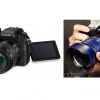Us photographers and filmmakers have never had it so good. The average consumer now has access to still camera and video camera technology that literally cost tens, if not hundreds of thousands of pounds only a few years ago. Now that you or I can, for less than £1,000, pick up a bunch of kit that produces full-HD footage that would have no trouble gracing a cinema screen, the camera really isn’t the limiting factor. But still us digital divas (me included) want more.
Well, I thought I wanted more. That is, until I realised that everything I’d want in my dream hybrid stills and video camera is already out there. Unfortunately though, it’s not yet all in one camera. This isn’t entirely surprising of course; different cameras have different target markets and intended uses. I often find myself working in environments where space is at a premium and it’s just not feasible to take a whole load of cameras. I’d love to be able to have just one camera system that does everything- for both stills and video – and does it well.
I need a Frankencamera!
The “Body Parts”
So, if I was making my dream, all-in-one photo and video camera, which existing cameras would I chop up to create it. The list goes like this:
Canon EOS 5D Mark III
This is so close to being my perfect stills and video camera straight out of the gate but for one problem. The video resolution is just not great. The 5D Mark III has made some great advances over its dad; the 5D Mark II. One of the main complaints of the Mark II however- mushy resolution that can’t really be classed at 1080p- has not changed. So, I don’t like the video resolution but what WOULD I take from the Canon 5D Mark III? Well, an awful lot actually:
- Full-frame sensor
- Very good stills quality – in fact, close to my perfect still photography camera
- Brilliant auto-focus system for stills
- Weather-sealed body
- Very low noise at high ISOs when shooting video (great in low light)
- Virtually no moire / aliasing artifacts in video mode.
- Headphone monitoring of audio and adjustment of sound levels while recording
- Lackluster detail/resolution in video mode
- No in-camera stabilisation for hand-held shooting (some lenses feature a stabiliser but not all of them)
[Hacked] Panasonic GH2
I LOVE this camera for video work. Its “Micro Four-Thirds” sensor is not much more than half the size of that found in the Canon 5D Mark II and 5D Mark III so you can’t get the same shallow depth of field effect. For me however, this is more often a positive than a negative. The small sensor allows the camera and lenses to be tiny and it allows me to shoot with very wide aperture lenses in low light and still have a manageable depth of field to give me at least half a chance of being in focus. Also, a Russian whizz called Vitaly Kiselev (check out his forum site PERSONAL VIEW) has managed to hack the camera’s firmware to unlock far greater video quality than the camera has off the shelf. In fact, it’s this balls-out quality that gets it onto my list. When it comes to resolution, a hacked Panasonic GH2 can happily compete with huge cinema cameras costing tens of thousands of pounds more than itself (see HERE and HERE). So from the hacked Panasonic GH2 we take:
- Exceptionally high video resolution
- Very small, light and unimposing
- Robust, high bitrate codec
- Not weather-sealed
- Not great at high ISOs (though high level of detail means noise reduction software works well)
- Smaller sensor not as good for stills as full-frame (less control over depth of field, lower dynamic range, worse in low light, lenses have to be sharper to resolve same level of detail)
- No in-camera stabilisation (as for Canon 5D Mark III)
Olympus OM-D E-M5
I wanted to love this camera but, from the footage that I’ve seen, it’s a case of, “close, but no cigar”. The in-camera stabiliser combats camera movement in 5 axes (if you can imagine that without looking at THIS, you’re probably autistic) and looks to do a bloody good job of it too. It’s weather sealed; something that this fella even saw fit to test by having a shower with his (I REALLY don’t recommend doing this and if you’re stupid enough to try it, I’m not responsible for what happens!):
It still only has a micro four-thirds sensor in it, like the Panasonic GH2, but the stills quality looks much better from what I’ve seen. What’s crippling it are the decisions that Olympus made when designing the firmware; the in-built software that the camera runs on. It can only shoot at 30 frames per second. No 24p, no 25p. Also, the video footage is very, very compressed which really makes the quality suffer. Maybe Vitaly can do something to unlock the potential of this little camera but otherwise, it’s just not quite there:
- Very small and light
- Very good stills quality for a micro four-thirds camera
- Weather-sealed
- Very impressive in-camera stabiliser would be very useful for shooting handheld where a tripod can’t be used
- Only shoots at 30 frames per second- no 24p or 25p
- Video codec (compression) not really up to scratch
Nikon D800
You’ll find opinions on the Nikon D800 vs Canon 5D Mark III all over the internet. There is no right choice, just a choice that suits your particular style of shooting better. They’re both great manufacturers whose gear I’ve owned and used a lot and I have no bias towards either. For me, the Canon 5D Mark III would just about be a better fit. On the stills front, they’re pretty much neck and neck for me. I don’t really need the D800’s 36 megapixel images but, if the better dynamic range shown in tests proves to be significant in real-life shooting, it could be a big benefit. For me, though, this might be outweighed by the Canon 5D Mark III’s faster burst rate (6 frames per second to the D800’s 4 fps) and reported better ability to deal with mixed lighting situations. Anyway, for stills, we’ll call it a tie.
For video, I’d much rather take the Canon 5D Mark III. Although the D800 has better resolution and detail, it looks to suffer from moire and aliasing and is quite a bit worse for low-light video shooting (that 36MP sensor doesn’t come for free!). The Nikon D800 does have one trick up its sleeve though; it can output a clean, uncompressed signal through its HDMI port, to an external recorder like the Atomos Ninja 2. To be honest, I haven’t really seen any evidence that this provides much of an improvement over the D800’s compressed footage that is recorded to the internal memory card, as it seems that the D800 is doing a pretty good job with compressing this internal footage. For other cameras for which the internal codec is a real weak point (I’m looking at you Olympus OM-D), and therefore for our Frankencamera, this could be a massive benefit.
So, from the Nikon D800 we take:
- Clean, uncompressed output through the HDMI port
- Wide dynamic range sensor
- Video quality really suffers at higher ISOs
- Reports of white balance problems under mixed light (NOTE: I haven’t yet used a D800. While I’ve read about these problems from a few trustworthy sources, I haven’t seen them for myself)
A Curve-ball – The Nikon D70
“What the hell are you talking about!?” I hear you cry. The Nikon D70 was announced in January 2004. Yep, eight and a half years ago! For the most part, it’s old tech now but there’s one feature that I’d love to see a modern implementation of. That is the fast flash sync made possible by its weird, hybrid mechanical-electronic shutter design. I won’t go into it in too much detail but, suffice to say, it lets you use small flashguns in a way that you can’t do with any modern camera, by allowing you to use a full flash blast at 1/1000th of a second or even faster without losing any apparent power (it’s not the same as Canon’s HSS or Nikon’s FP modes which do lose power with increased shutter speed- see HERE for more info). This lets you use tiny, hotshoe flashes as if they were big studio light with four times the power but without any of the bulk.
If an updated version of this kind of system was implemented into a new camera, I’d rush out and buy one tomorrow but, alas, I think this system has probably been retired for good.
- Full flash power at 1/1000th of a second – unprecedented ability to overpower daylight with small flashguns
- Pretty much everything else compared to more modern DSLRs (6 megapixels, 5 AF points, tiny viewfinder, maximum ISO of 1600, 1.8″ screen, no video mode…you get the idea)
Honorable Mentions
There are a few cameras that also come very close to being the perfect shooting tool but have one of more big stumbling blocks (not that the Nikon D70 doesn’t have a few!). The Canon 1DC is shaping up to be a truly incredible hybrid DLSR camera. It’s part of Canon’s Cinema EOS range and is basically a Canon 1DX with cinema quality, 4k video. It is very close to my perfect camera but for one small problem. Actually, fifteen thousand small problems as that is the number of US dollars you’d have to shell out to own one, and that’s before you even start thinking about lenses. Unfortunately, that puts it outside the reaches of all but the big production houses. The C300 also looks like a bloody good video camera. The detail is exceptional, low-light performance is great but it doesn’t take stills. At all. It’s also quite a bit bigger and therefore quite a lot less subtle than a DSLR. That doesn’t mean that it’s not a great camera, it’s just not our do-it-all camera. Also falling into this category is the Sony FS-100 and the newly announced FS-700. The FS-100 has proven to be a fantastic camcorder despite its ergonomic madness but it can’t take stills and is not weather sealed. The as-of-yet unavailable Sony FS-700 is shaping up to be a beast of a video camera and does actually have an 8 megapixel stills function but I wouldn’t expect it to be able to compete with a true hybrid camera when it comes to still photos.
Conclusion
So there they are, the components of my dream camera:
- Full-frame sensor (Canon 5D Mark III, Nikon D800)
- Brilliant auto-focus system for stills (Canon 5D Mark III, Nikon D800)
- Weather-sealed body (Canon 5D Mark III, Nikon D800, Olympus OM-D)
- Very low noise at high ISOs when shooting video (Canon 5D Mark III)
- Virtually no moire / aliasing artifacts in video mode. (Canon 5D Mark III)
- Headphone monitoring of audio and adjustment of sound levels while recording (Canon 5D Mark III)
- Exceptionally high video resolution (Panasonic GH2)
- Robust, high bitrate codec (Panasonic GH2)
- Very small, light and unimposing (Panasonic GH2, Olympus OM-D)
- Very impressive in-camera stabiliser (Olympus OM-D)
- Clean, uncompressed output through the HDMI port (Nikon D800)
- Wide dynamic range sensor (Nikon D800)
The big question is, “When will it happen?”
Well, there’s always the Panasonic GH3 or Sony A99 or 5D Mark IV or Nikon D900 or…






Markus Arike
Interesting write-up, but a D800 and 5D Mk III "a tie for stills"? That's generous in favor of the 5D III. Are two frame additional motor drive that important? Anyway, FPS for photography has nothing to do with IQ, and the D800 IQ is way ahead of the 5D III, which has mediocre DR performance. Anyway, nice list.
Ross Fairgrieve.com
Personal preference I guess Markus. For out-and-out image quality, I absolutely agree that the D800 is the better camera but there are real-world idiosyncrasies of each camera that effect how you use it and whether you can get that image. For me, the faster frame rates, slightly more solid auto focus performance, better implementation of live view etc, just about make up for the D800's better DR and higher resolution. For IQ, yep the D800 wins but, as complete photo making machine, I put them about even. Why can't one camera just have all of this hey!?
Markus Arike
Interesting write-up, but a D800 and 5D Mk III "a tie for stills"? That's generous in favor of the 5D III. Are two frame additional motor drive that important? Anyway, FPS for photography has nothing to do with IQ, and the D800 IQ is way ahead of the 5D III, which has mediocre DR performance. Anyway, nice list.